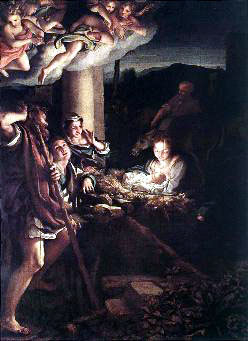|
 There has been some dispute about the proper date of the birth of
Christ, and even to this day not everyone agrees. It was not until AD
350 that December 25 was declared the official date for celebrating
Christmas by Pope Julius I. When the fathers of the church decided to
settle upon
a date to celebrate the event, they wisely chose the day of the winter
solstice, since it coincided with some rival religions' celebrations and
the rebirth of the sun, symbolized by bon-fires and Yule logs. December
25 was a festival long before the conversion of the Germanic peoples to
Christianity; it seemed fitting that the time of their winter festival
would also be the time to celebrate the birth of Christ. The coming of
Christ forever defeated the darkness that had frightened and threatened
to defeat the ancient pagans.
There has been some dispute about the proper date of the birth of
Christ, and even to this day not everyone agrees. It was not until AD
350 that December 25 was declared the official date for celebrating
Christmas by Pope Julius I. When the fathers of the church decided to
settle upon
a date to celebrate the event, they wisely chose the day of the winter
solstice, since it coincided with some rival religions' celebrations and
the rebirth of the sun, symbolized by bon-fires and Yule logs. December
25 was a festival long before the conversion of the Germanic peoples to
Christianity; it seemed fitting that the time of their winter festival
would also be the time to celebrate the birth of Christ. The coming of
Christ forever defeated the darkness that had frightened and threatened
to defeat the ancient pagans.
The time
of the solstice and the date of Christmas vary by a few days because of
the changes in man-made calendars. As Christianity spread among the
peoples of pagan lands, many of the practices of the winter solstice
were blended with those of Christianity. In the dead of winter, a
celebration of rebirth of life was symbolized in the birth of Christ.
The time of the winter solstice, when days grew longer again--the return
of the light--became the hope of the world in the birth of Christ,
"the light of the world."
Since the middle of the 4th century the church has celebrated
Christ's birthday as December 25. From the 8th century up until the
Reformation this was also the beginning of the New Year in Germany.
People still viewed the "Rauhnaechte," the twelve nights of
Christmas, as a time when ghosts appeared, and dead warriors swept
through the night. People lit candles, locked their doors, and stayed at
home. The church was gradually able to give pagan customs Christian
significance, but without completely replacing the old popular beliefs.
Details of the Christmas story are found in the New Testament's
four books of the gospel. From this, we have created a Jesus vita and a
story that suits us, but it ignores somehow the historical context.
There are those who say that if shepherds really were tending their
flocks that night, it must not have been winter, for in the winter,
sheep in Palestine were penned at night. The abode of Christ's birth was
not the kind of stable usually pictured, but most likely a hillside cave
which sheltered livestock. Mary and Joseph may have camped in a
livestock enclosure where the baby was born wrapped and laid in a
manger. Rugged shepherds in the dark fields near the compound were
frightened by heavenly music and voices about an occurrence of
"great joy" for "all of the people."
Biblical
evidence indicates that when the Magi or wise men visited the child
Jesus, he was a toddler, about 2 years of age, not a newborn infant as
typically portrayed. The wise men from the East (possibly from Persia
and a year's journey away) are said to have found Mary and Joseph's
house (they explicitly had a house by this time) and presented gifts.
Most depictions of the Wise Men are based on tradition, and
tradition says that there were three while St. Augustine and St.
Chrysostom said there were 12. Tradition expands upon the story with a
rich biography. It says they were Melchior, King of Arabia, age 60, who
brought a casket of gold, Caspar, King of Tarsus, 20, who brought myrrh
in a gold mounted horn, Balthasar, King of Ethiopia, 40 who brought
frankincense in a censer. Gold symbolizes Kingship; frankincense is a
gift for a high priest,
and myrrh for a great physician. Tradition assigns the date of this
visit to January 6, Epiphany, known as Twelfth Night.
--
--
|





